Dirty Rice is too bold and delicious to call it merely a side dish. A very popular accompaniment for meats, fowl, and seafood in South Louisiana cooking, Dirty Rice is made by simmering browned meats with the Trinity (onions, green peppers, and celery), Cajun/Creole spices, rich stock, and cooked white rice. A version of this dish (and there are endless versions) will always be found at family gatherings and holiday celebrations in South Louisiana. Here's how to make Sweet Daddy D's Cajun Dirty Rice!
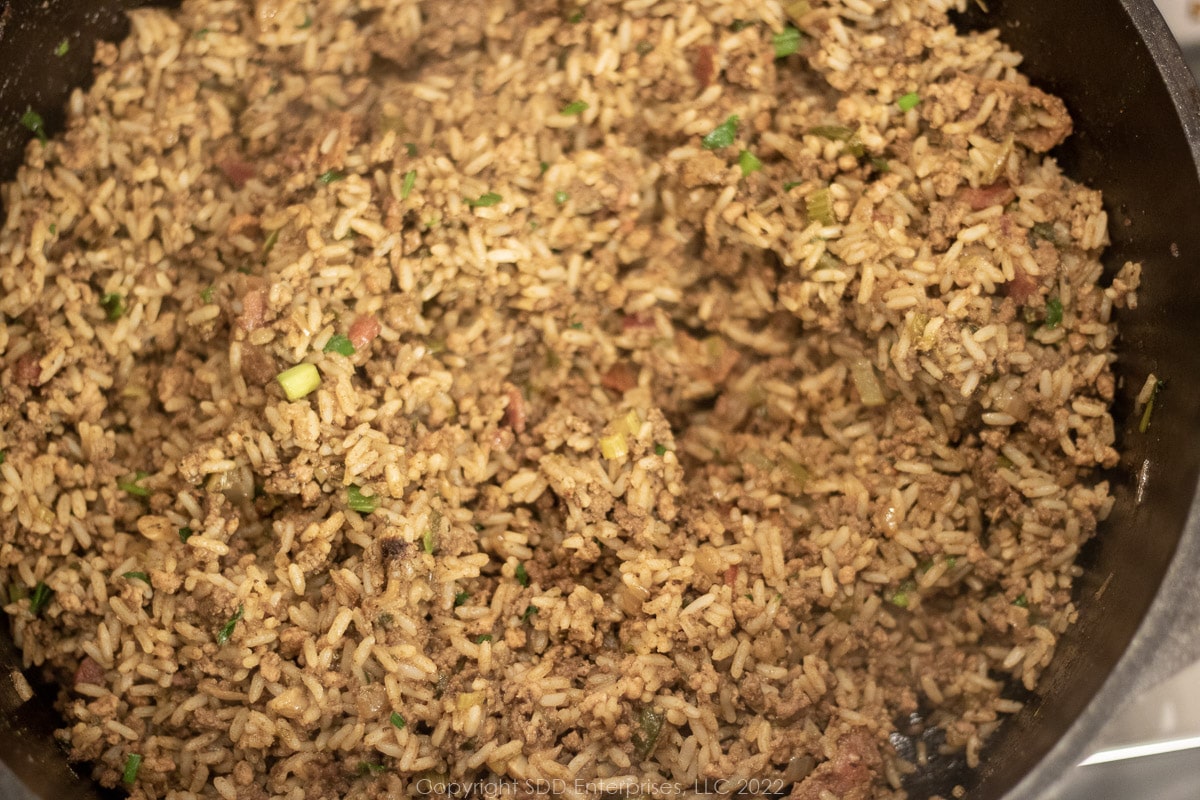
If you want to just skip to the recipe, click the "Jump To Recipe" button above or the Recipe link below and you’ll go right there without having to scroll through my article.
This post is not sponsored, but you will find affiliate links on this page. As an Amazon Associate, I earn from qualifying purchases. The price you pay as a consumer does not change, but I may make a small commission based on your purchase.
[Publishers Note: I originally published this recipe and article in November 2018. Since that time I have made a few updates, but I am now republishing the article to give it some structural improvement and updates to the images. The goal is to make it more search-friendly. The web never stops evolving! Let me know what you think and if you have any suggestions to make this article more helpful to you. I love questions and comments from you. Enjoy!]
Jump to:
What is Dirty Rice?
Like many popular dishes in South Louisiana, the origins of Dirty Rice can be traced back to the 19th century, when the better cuts of meat and poultry were saved for the rich and the cheaper, tougher cuts were left for the poor. This included things like the chicken livers, gizzards, and hearts. It's a common theme: make something tasty with what you have that can be stretched to feed a large family.
What they had lots of was some lesser cuts of meat, the innards of the chickens, and of course rice, which was very plentiful in Louisiana. It's not unusual in Louisiana cuisine for dishes of humble origins to find their way to local restaurants, both simple and fancy, and soon become popular ambassadors of Louisiana cuisine. After all, why do you think Popeyes has been hawking Cajun Rice all over the world for years? It started in poor ole rural Louisiana in the 19th century!
Authentic Dirty Rice will contain some organ meat, usually chicken liver, gizzards, or even hearts. The “dirty” part of the name comes from the brown appearance the rice takes on from the browned ground meat and organ meats.
Here’s What You Need
Here are some of the key ingredients for this recipe:
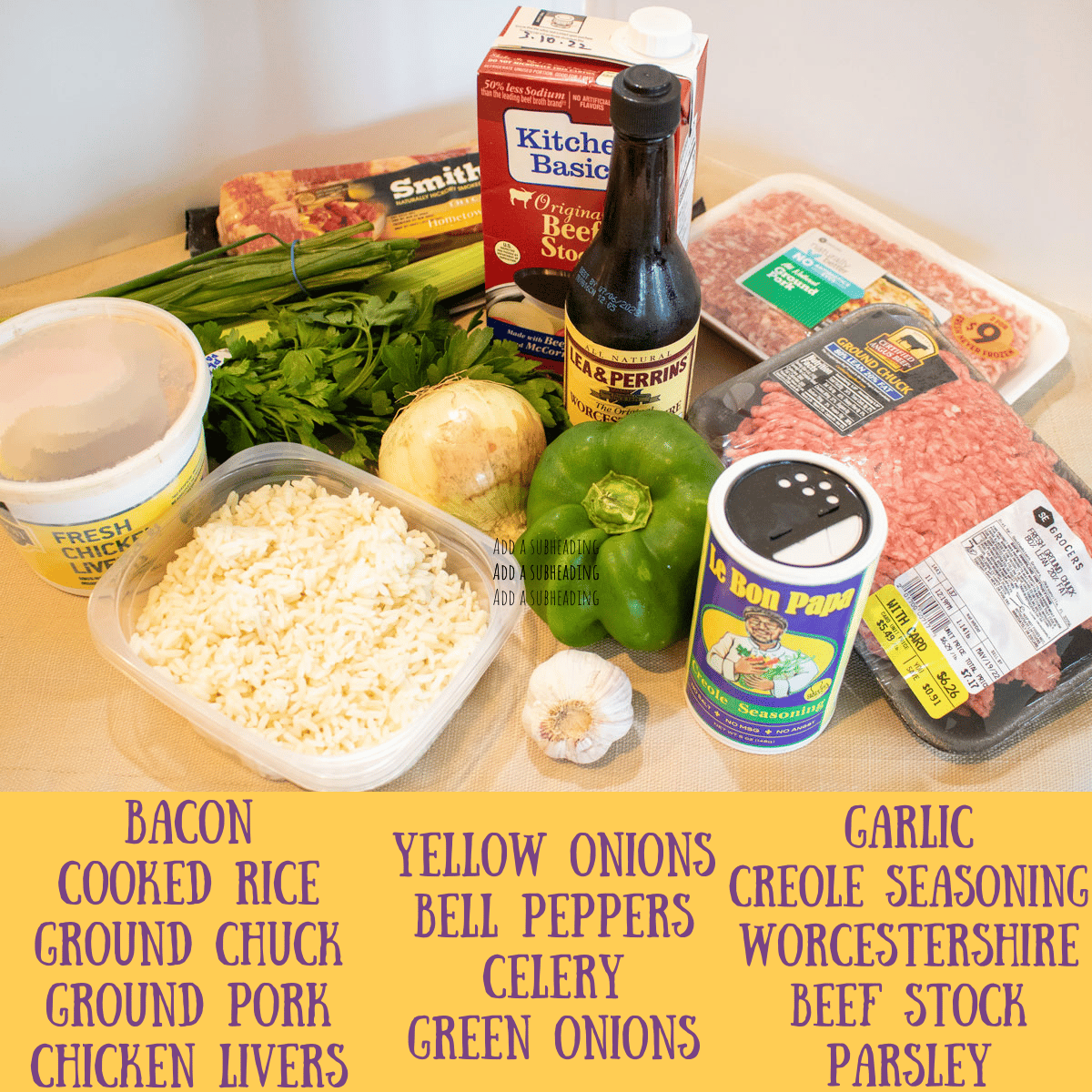
Note on the rice: This is a perfect use for leftover rice. If you don’t have leftover rice, cook some rice the day before if you want and keep it in the fridge. If you don't have time to do that, just cook some rice while you're preparing the other ingredients. I use converted (parboiled) long grain white rice. You can use your favorite rice, just make sure it's cooked.
Equipment
Here is some of the equipment I used in making this recipe:
This post is not sponsored, but you will find affiliate links on this page. As an Amazon Associate, I earn from qualifying purchases. The price you pay as a consumer does not change, but I may make a small commission based on your purchase.
Here’s What You Do
First...you have a beer. Let’s get off on the right foot. You should read the recipe all the way through before you start to cook. That's best done with a cold beer. To make this truly no-angst, learn what you will need and what you will do with each ingredient before you start. Then, do your mise en place, which is preparing all the ingredients before starting to cook. That being done, all that is left is to assemble the recipe as you cook. No angst and fun...take a swig!
Mise En Place
Measure and prepare all of your ingredients and place them into individual prep bowls. Ingredients that are added at the same time can go in the same bowls. Chop the Trinity, the garlic, the green onions, and the parsley. Chop the bacon or measure out the bacon grease. Place the meats together in one prep bowl. The chicken liver (and gizzards, if used) will need to be prepared before adding them to the recipe, so set those aside. Measure the cooked rice, stock, Worcestershire sauce, and Creole Seasoning.
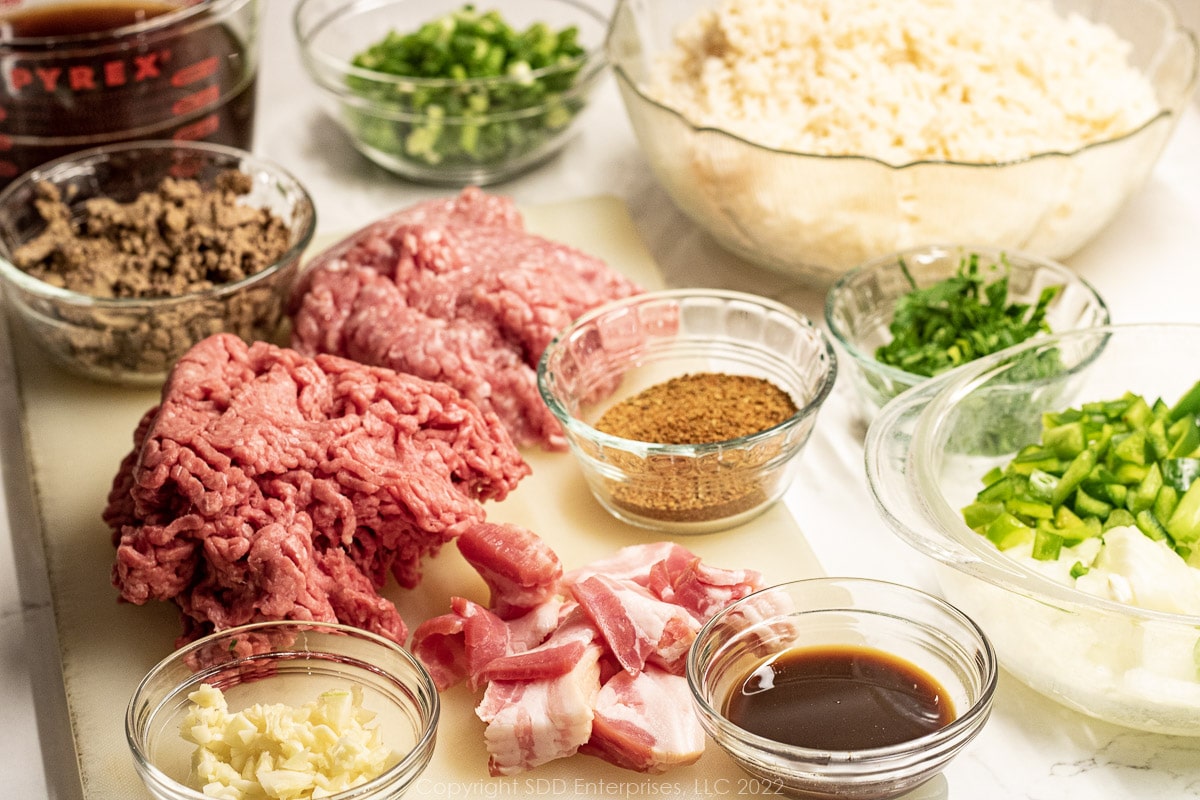
Notes on preparing the livers: Cook the chicken livers (and gizzards, if using) in advance of adding them to the recipe. Place them in a pot of enough slightly salted water to cover them, bring it to a boil then let it simmer until tender, about 15 to 20 minutes. Use a slotted spoon to take the cooked livers out of the water and let them cool, make sure to reserve the cooking water. Remove and discard any hard cartilage from the gizzards. Once cooled, give them a rough chop and set them aside until you need them.
Pro Tip: 15 to 20 minutes seems like a long time to cook the livers, but I want the livers to be very soft so that they completely blend and disappear into the other ingredients.
Start with the Meats
What happens in this step? To maximize the flavor of Dirty Rice, it must be built in layers. The foundation layer starts with browning the meats in bacon grease. Here's how we do that:
Start out by melting the bacon grease or frying bacon pieces over medium-high heat in a dutch oven.
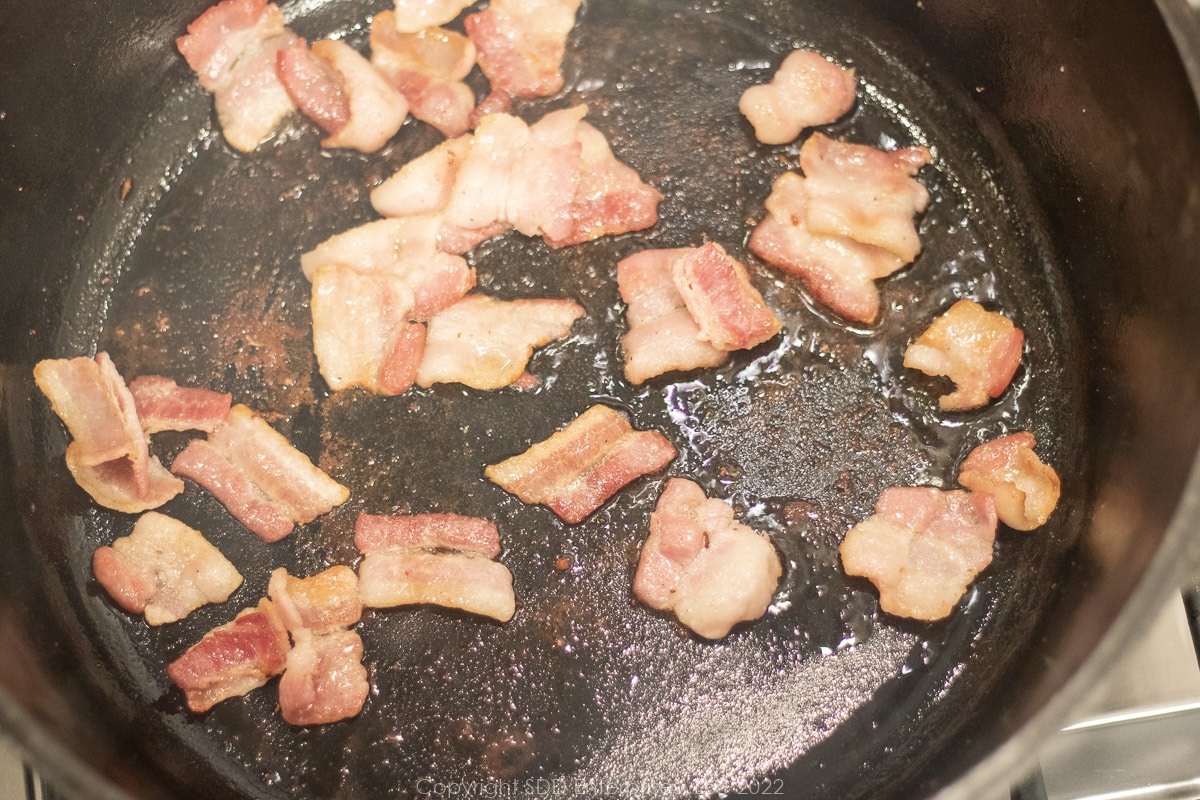
Break up the beef and pork into the bacon grease, stir while you fry and when the redness is gone, about 5 minutes, mix in the chopped chicken livers (and gizzards, if using). Cook all this together for another 5 minutes. Scrape up anything that sticks to the bottom of the pan. These little bits of goodness are called fond and add lots of serious deliciousness.
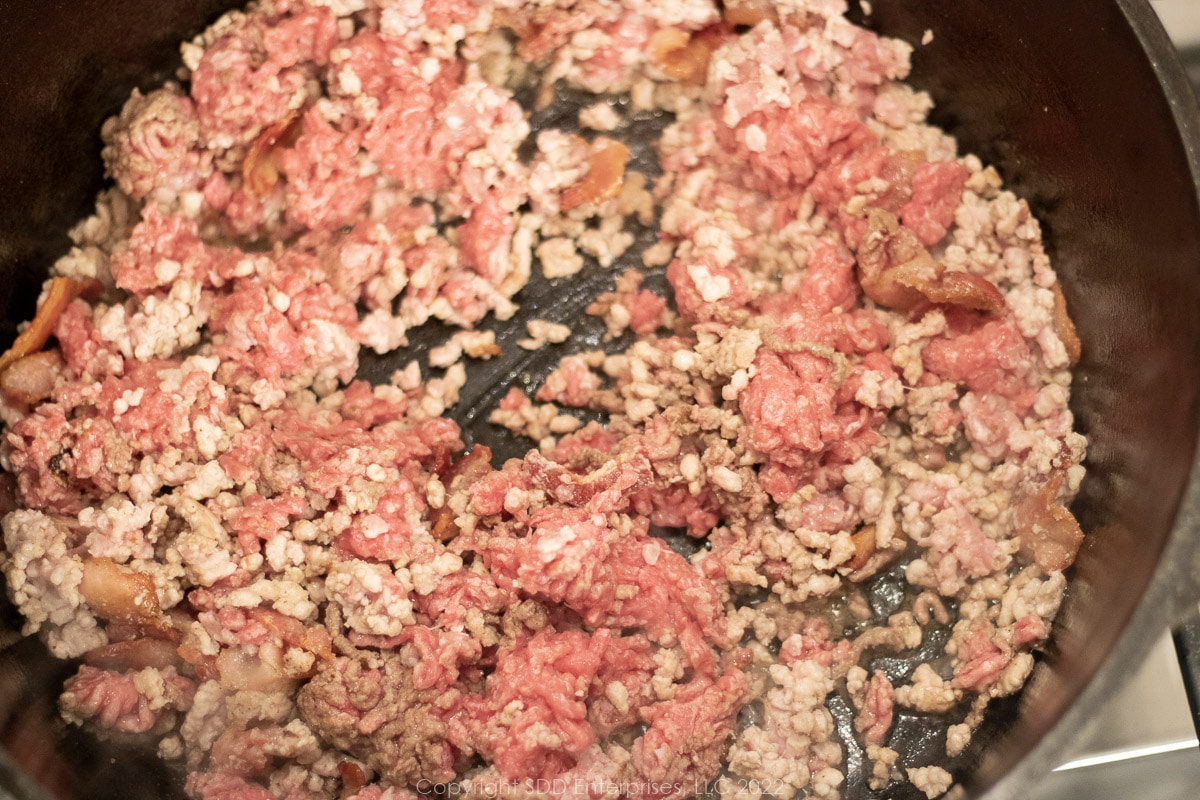
Pro Tip: Use a little beef stock to deglaze the bottom of the Dutch oven to release the fond back into the meats.
Time for the Trinity and concentration of the flavor
What happens in this step? Now that we have the foundation flavor built, the Trinity and aromatic will be added, then concentrated by simmering in a rich stock until the stock reduces, intensifying the flavor.
Add the Trinity to the meats. Saute until the onions are starting to brown which should be about 8 minutes.
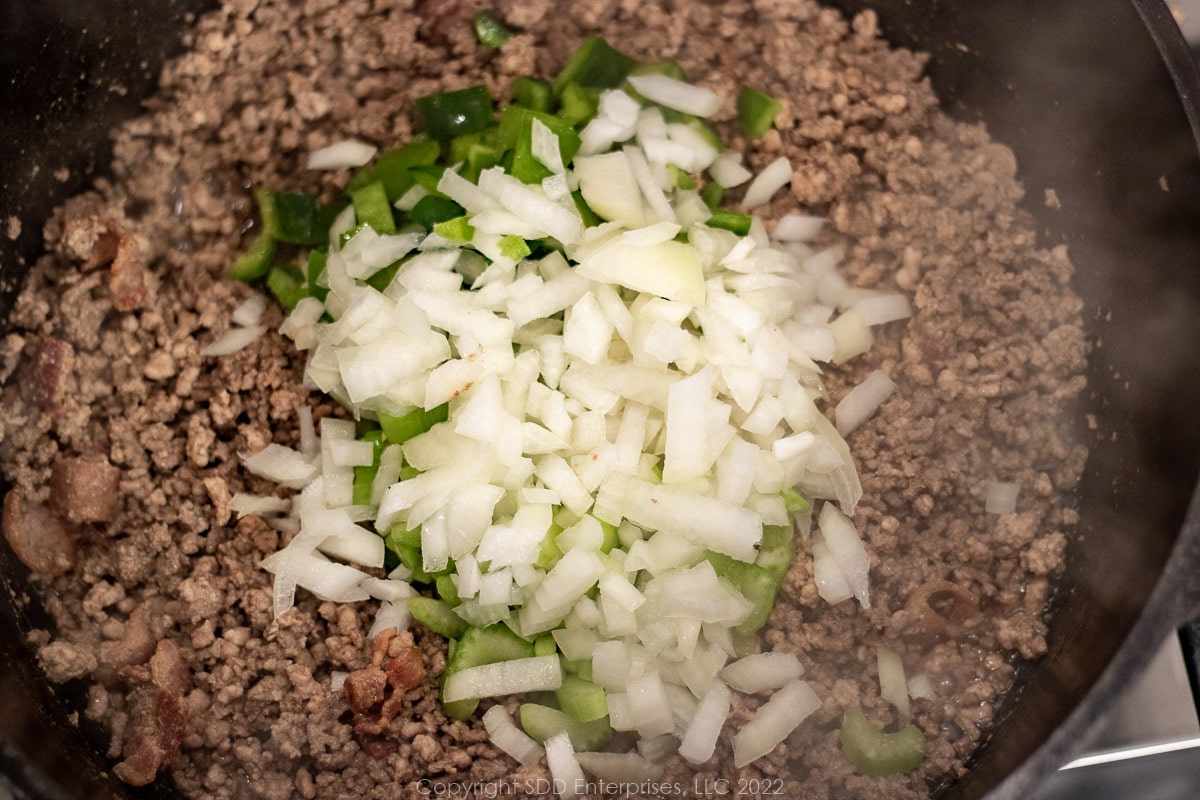
Stir in half the green onions and continue to sauté for a couple of minutes.
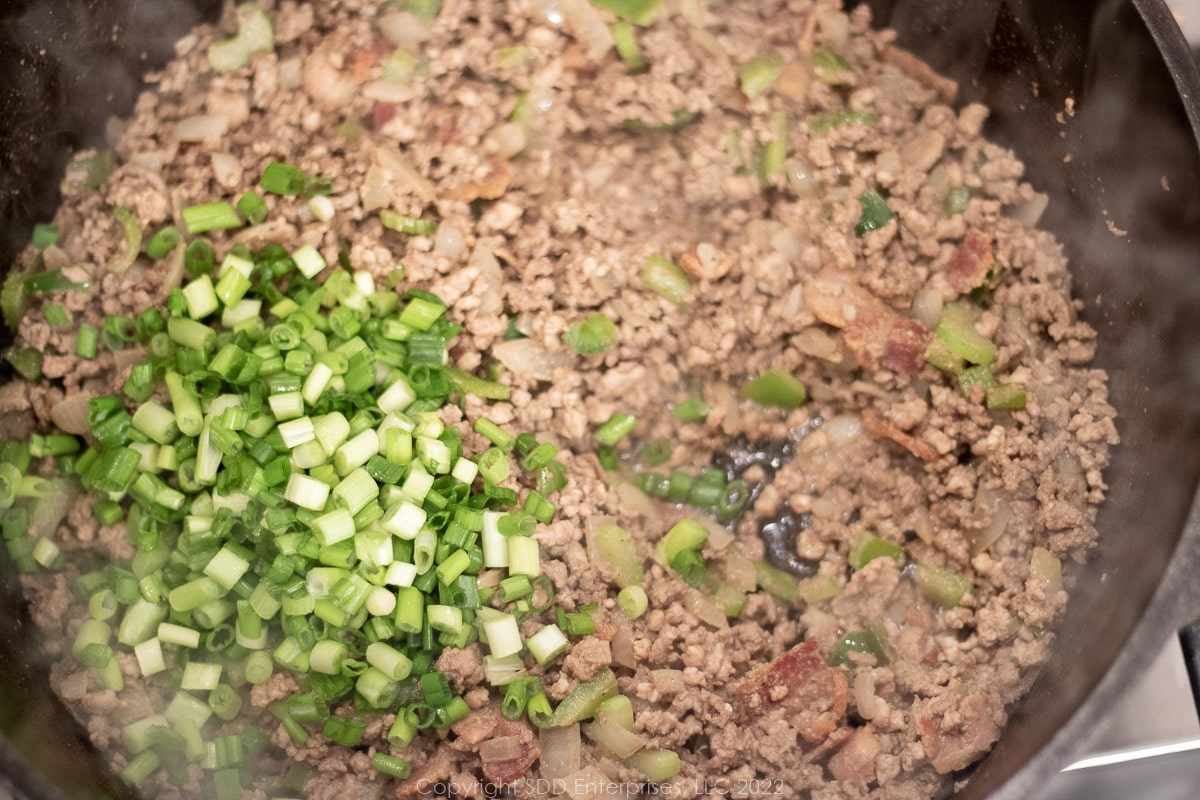
Add the garlic and continue to sauté until the garlic is aromatic, which only takes a minute or two.
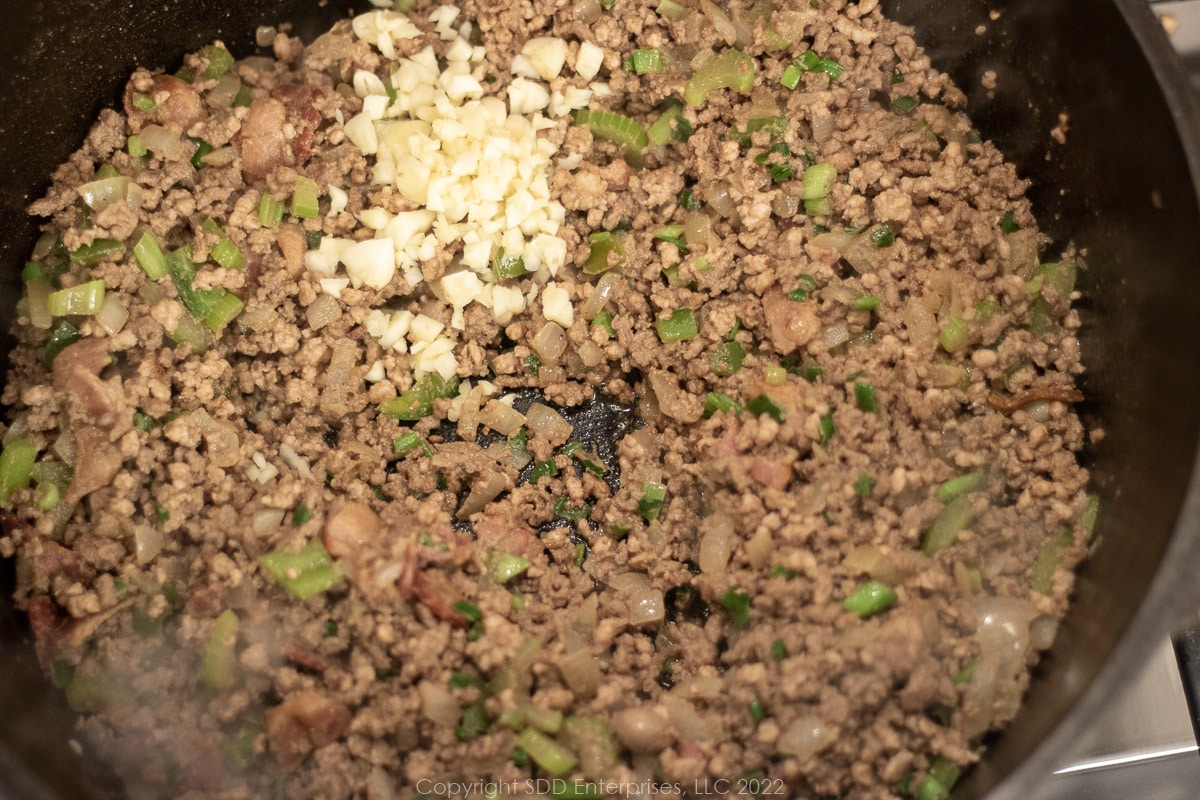
Now add the Creole seasoning.
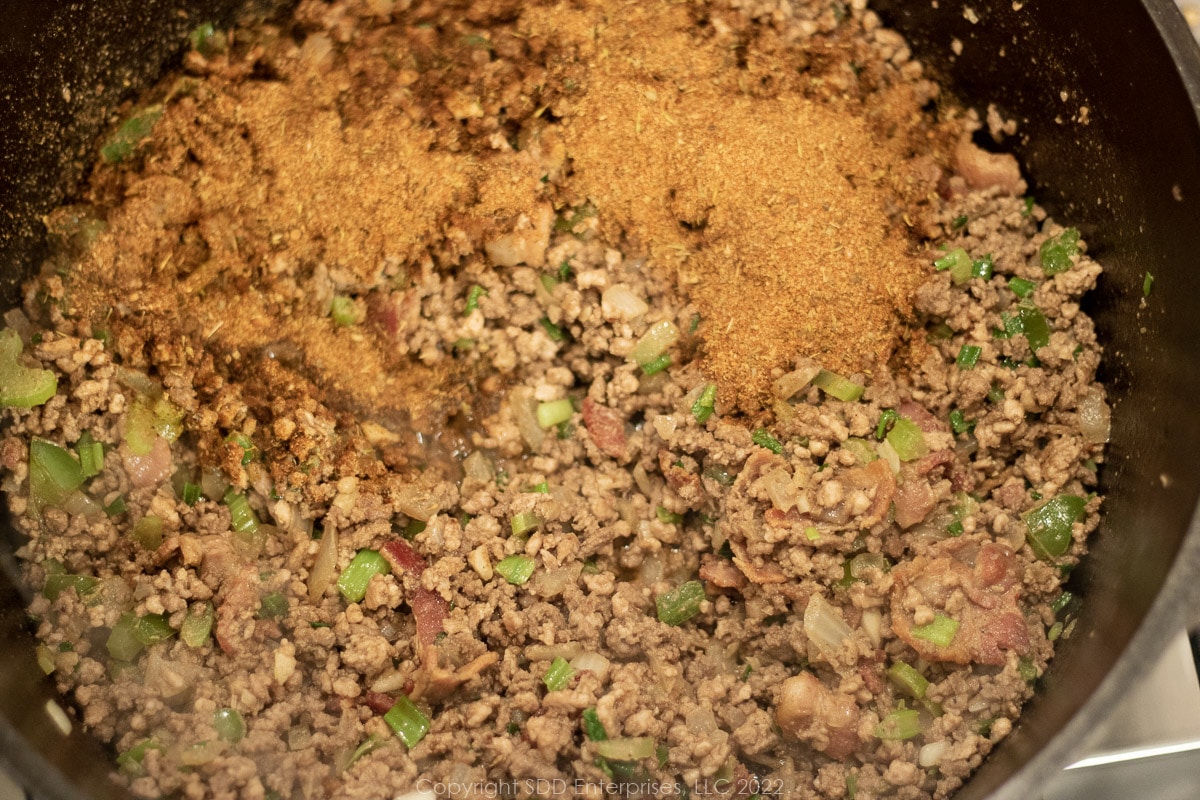

Next, toss in the Worcestershire sauce and mix well, continuing to sauté for a minute or two. Add the stock and a little of the reserved water from boiling the chicken livers. (If you have some fond stuck to the bottom of the pot, start with just a little stock to deglaze the bottom. This will mix all that delicious fond-flavor right in before adding the remaining stock.)
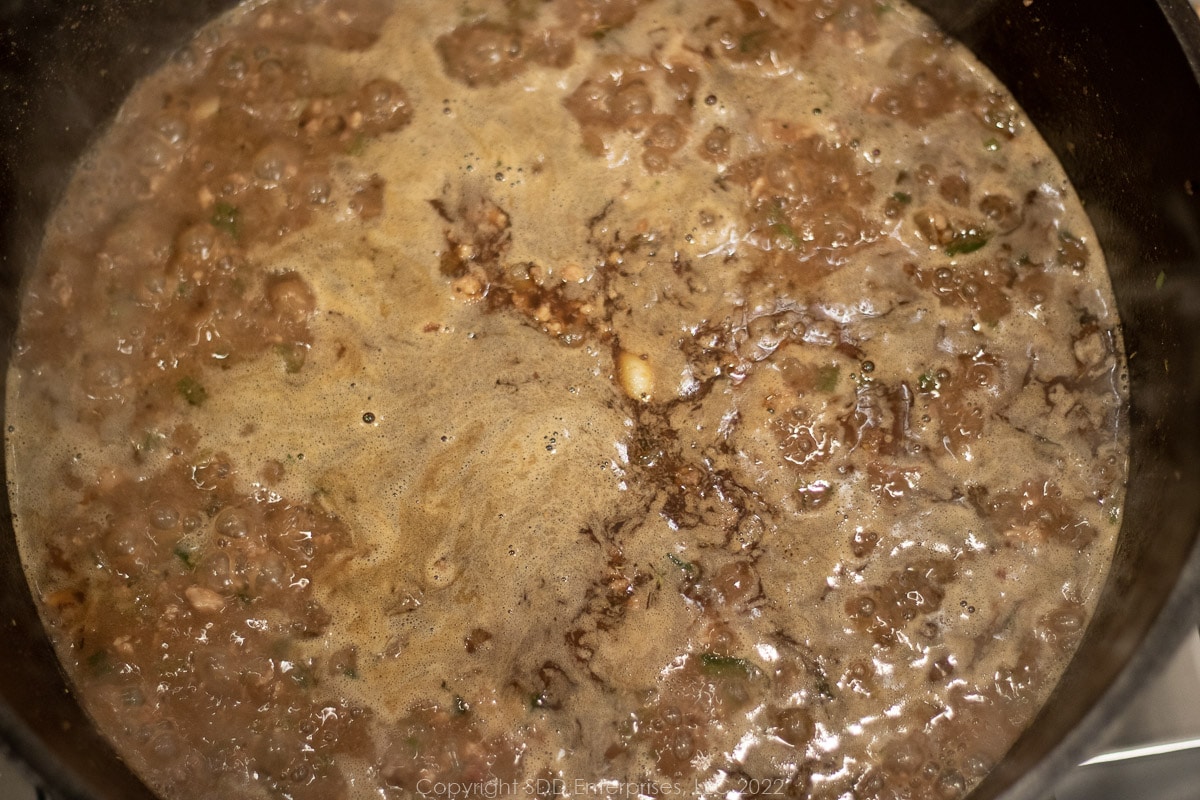
Stir everything together and bring it to a high simmer, uncovered, until the liquid is reduced by a little more than half, which should take about 20 to 30 minutes. This is going to concentrate all that flavor you've been building at each step.
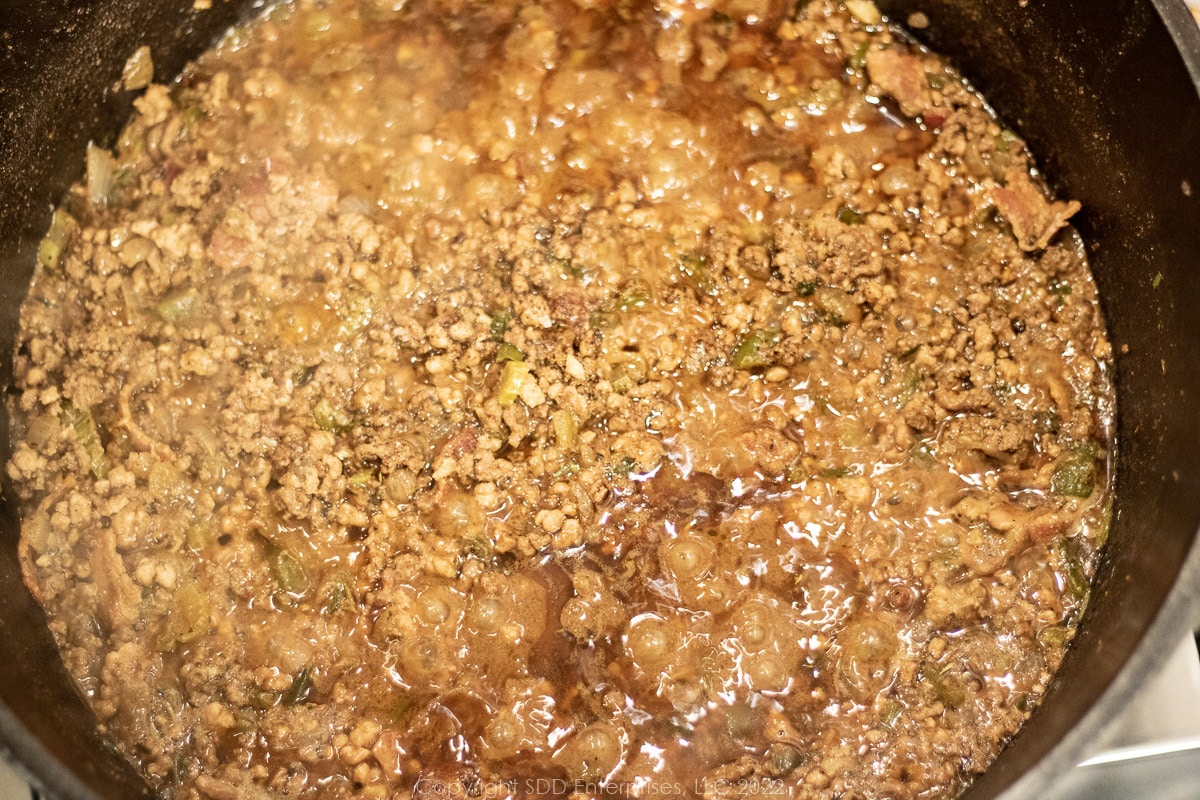
All you need is the rice
What happens in this step? It ain't Dirty Rice without the rice. Cooked rice serves as the vehicle to distribute the intense flavor profile we've built into every single bite.
Once everything is looking and smelling good and the liquid is cooked down quite a bit, it's time to make the rice dirty. Add the cooked rice and blend well to incorporate all the ingredients-the rice ain’t white no more!
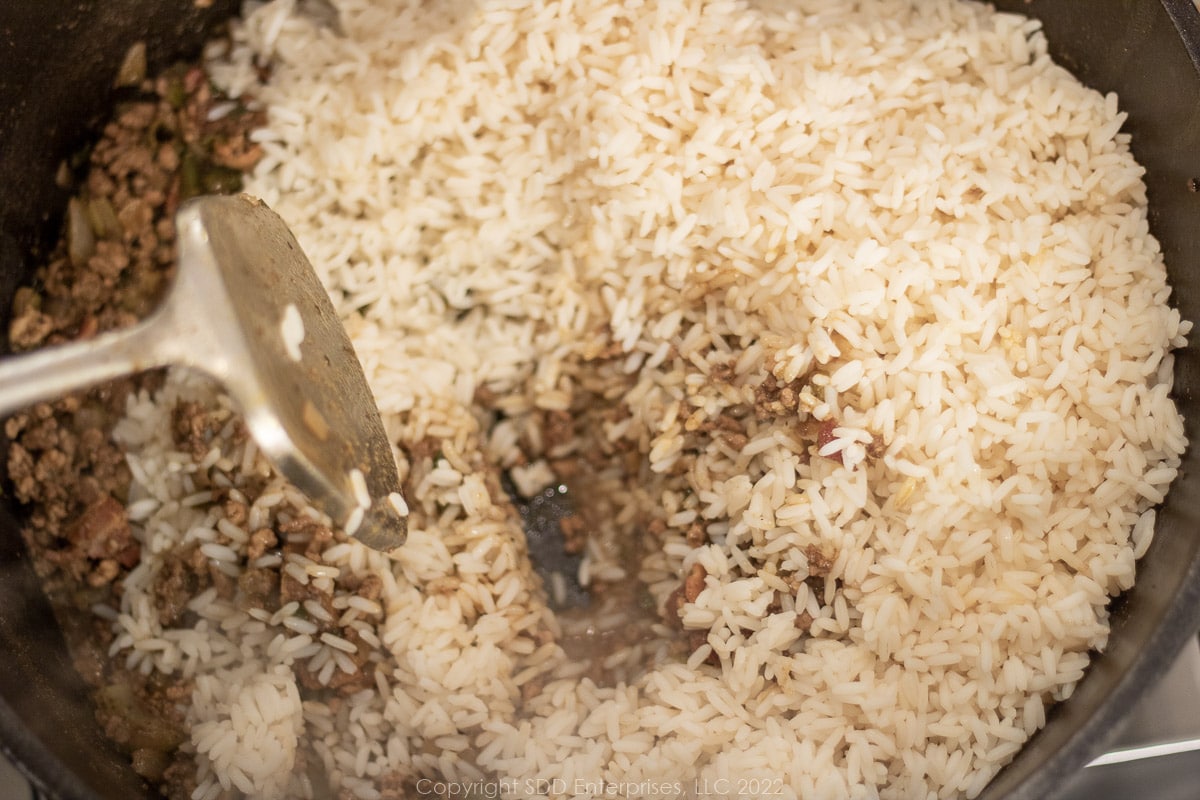
Add some kosher salt and ground black pepper. Mix in some parsley and the remaining green onions (save some to top the dirty rice when serving, though). Leave the fire on low for just another few minutes, uncovered, until all the liquid is absorbed. Taste it to see if you need more salt, pepper, or Creole seasoning. You are ready to dish it up-just sprinkle some of the reserved green onions on top when served.
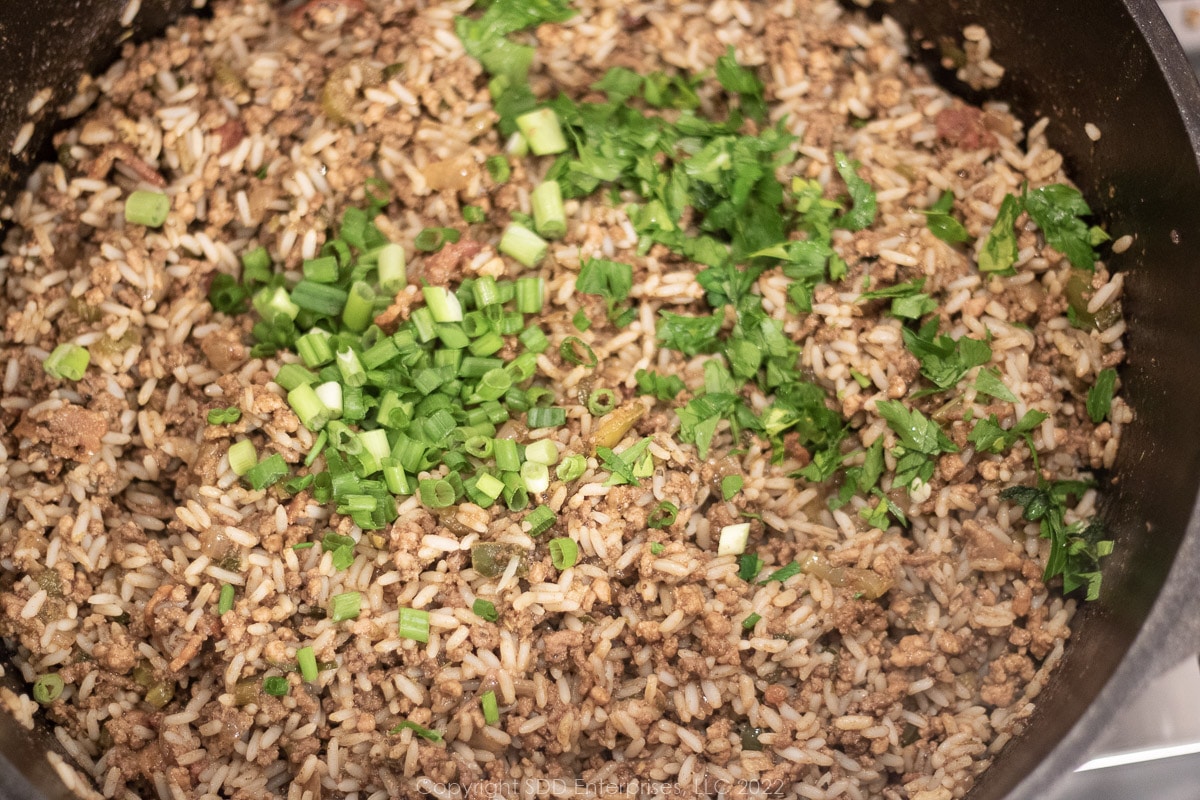
That's it, simple as that, all there is to it.
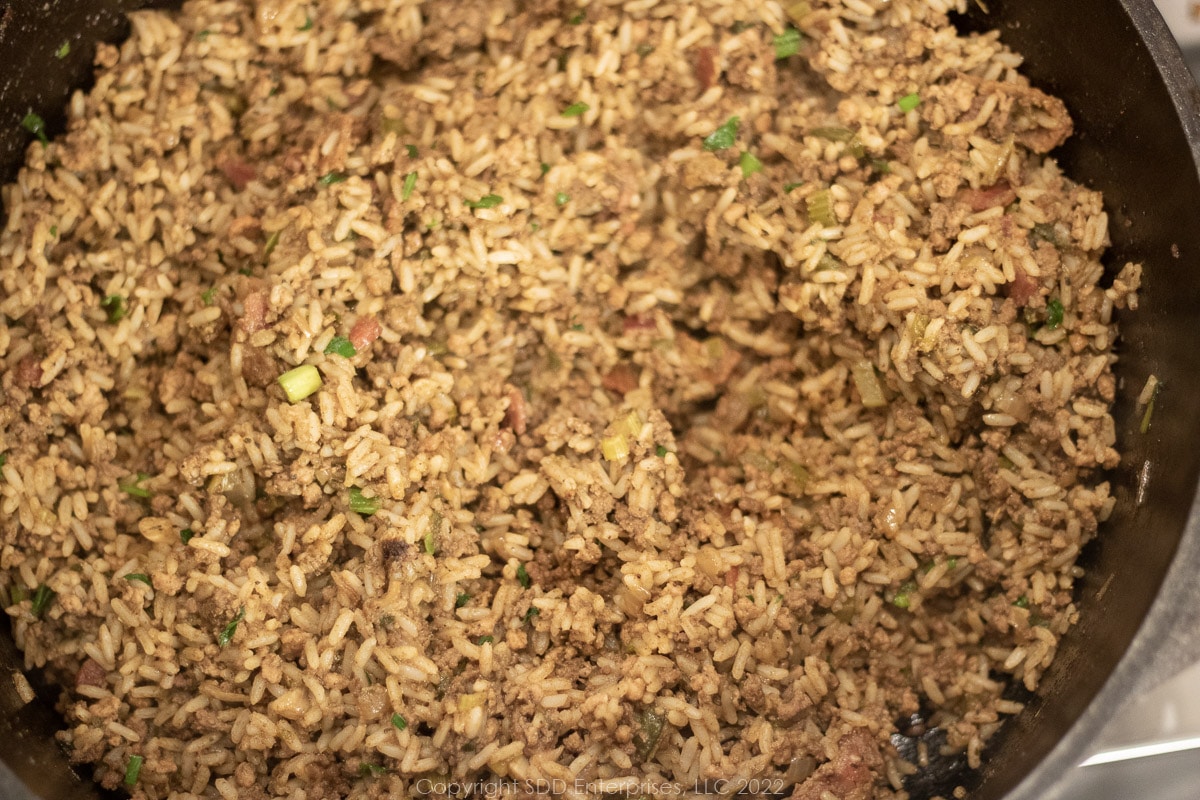
Sign up for my email notifications of new recipes and posts right HERE.
Hints and Tips (FAQs)
For this recipe, I use a combination of ground chuck (80/20) and ground pork. This blend provides enough fat and richness of flavor to really set this recipe apart. If you prefer to use one or the other, that's fine. Experiment...try some fresh bulk sausage or some other meats.
Not if you don’t want to. All the ingredients contribute to Dirty Rice's flavor, but none take over. Chicken livers add a subtle undertone to the flavor profile. Many recipes call for using the gizzards along with the livers, so that is certainly an option. Don't go overboard on the amount of liver you use because they can certainly take over the flavor profile if you let them. Most people won’t even know they're there. If you just can't do it, leave them out and you have a wonderful recipe for Rice Dressing!
You can substitute chicken stock, vegetable stock, or even water for the beef stock if you want. I prefer long grain converted rice (like Uncle Ben's) but you can substitute your favorite cooked rice.
The simple answer is that it can be frozen, but realistically white rice does not freeze well when mixed with other ingredients. I have read that Dirty Rice made with brown rice does freeze very well and may even be more authentic to the roots of this Cajun specialty. Let the Dirty Rice completely cool, then use a vacuum sealer. Dirty Rice will maintain its best quality for up to 3 months in the freezer. Defrost in the fridge overnight, then reheat on the stove or microwave.
If you want to cook Dirty Rice ahead, make it up to the point before you add the stock. Freeze the meat/vegetable in an airtight container. When you want to serve it, bring it back to temperature on the stove, Add the stock and continue with the instructions.
Dirty Rice can be safely refrigerated for 5 or 6 days if stored in an airtight container. To reheat, place the Dirty Rice in a saucepan, add a little water and place it over low heat. Break it up with a fork and stir a few times while the water evaporates. It should be nice and warm in 5 to 10 minutes. Just don’t turn the heat up too high! Reheating in the microwave also works.
It can be stored in the freezer for up to 3 months, again in an airtight container. Vacuum-sealed bags are the best option for freezing.
There are a lot of similarities between dirty rice and jambalaya, but they are not the same thing. They are both primarily rice dishes flavored with traditional South Louisiana seasonings. Each is an example of the South Louisiana heritage of stretching scarce resources into delicious and filling meals-nothing goes to waste! Like many Cajun and Creole dishes, the Holy Trinity (yellow onions, bell peppers, and celery) is an important part of their foundation, and the meats used are the less expensive cuts. Jambalaya builds its flavor by browning various meats (primarily pork, chicken, sausage, and sometimes seafood) and vegetables and combining those with rich stock in which raw rice is then cooked. The rice absorbs all those wonderful flavors. Dirty Rice builds its foundation by browning pork (and sometimes beef) and adding organ meat, generally chicken livers, and sometimes, gizzards and hearts. The earthy flavor that this imparts is very distinctive. The meats are cooked with the Trinity and rich beef stock and then cooked rice is blended in to combine all the wonderful flavors. These seemingly subtle differences produce uniquely special dishes.
Boudin is a sausage that shares many of the same ingredients as Dirty Rice. Boudin is unique among South Louisiana sausages because it contains pork and organ meat, cooked down in Cajun seasonings and spices, mixed with cooked rice before stuffing into sausage casings. Although the ingredients are cooked before being stuffed into the casing, Boudin is usually steamed before serving, but it is also common to find grilled boudin and smoked boudin.
Popeyes Fried Chicken was founded in St Bernard Parish, east of New Orleans. Their very popular side dish, Cajun Rice, is derived from Dirty Rice and is an excellent offering. Using the term “Cajun Rice” helps market the side dish in areas outside of Louisiana. Although I have never seen Popeye's recipe for Cajun Rice, I have it on good authority that it contains ground beef and ground chicken gizzards-no livers. Popeye's may have discontinued Cajun Rice in most stores, but we have been able to still find it in some South Louisiana Popeyes.
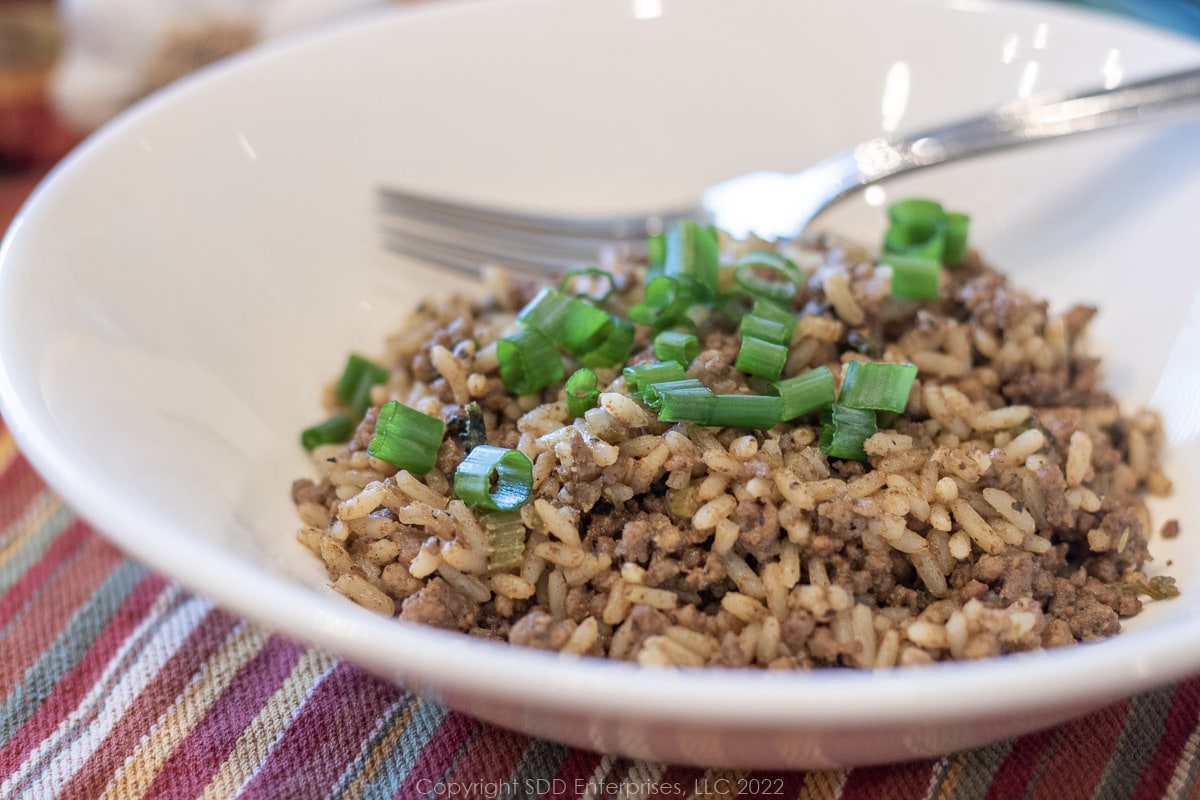
There are so many things that Dirty Rice goes well with. Here are a few suggestions from Sweet Daddy D!
Add some of these other great sides for a full meal!
More great Cajun and Creole Dishes from Sweet Daddy D!
If you make this recipe:
- Tell us about it in the Comments section below
- LEAVE A RATING ON THE RECIPE-worthy of 5-Stars?
- Questions or Comments? that’s the place!
- SIGN UP FOR OUR EMAIL UPDATES so you don't miss anything!
- Post a picture and share it with your friends on our Social Media:
Yeah You Right!
Recipe
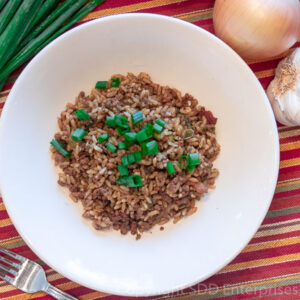
Cajun Dirty Rice
Here's What You Need
- 3 tablespoons bacon grease
- 1 pound ground chuck (80/20)
- 1 pound ground pork
- ½ pound Chicken livers
- 1 medium to large Yellow Onion
- 1 medium green bell pepper
- ½ cup Celery
- 2 bunches green onions in all
- 3-4 cloves garlic
- 4 tablespoons Creole seasoning
- 3 tablespoons Worcestershire Sauce
- 3 cups beef stock
- 6 cups cooked rice
- 4 tablespoons parsley
- Kosher Salt and Ground Black Pepper to taste
Here's What You Do
- Place chicken livers in water to simmer until tender, about 20 to 30 minutes. Let them cool then give them a rough chop and set aside; reserve the cooking water.
- In a dutch oven, melt the bacon grease (or fry bacon) over medium-high heat.
- Maintaining a medium-high heat, brown the beef and pork in the bacon grease; when the redness is gone (about 5 minutes), add the chopped chicken livers and mix well; cook together for another 5 minutes.
- Add the yellow onions, bell peppers and celery to the meats and saute until the onions are starting to brown, about 8 minutes.
- Stir in about half the green onions and then the garlic and continue to sauté for a couple of minutes until the garlic is aromatic.
- Add the creole seasoning and mix well, continuing to sauté.
- Increase the heat and add the Worcestershire sauce, the stock and a little of the reserved water from boiling the chicken livers; stir together completely and bring to a high simmer, uncovered, until the liquid is reduced by a little more than half-about, 20 to 30 minutes.
- Mix in the cooked rice and blend well to incorporate all the ingredients. Taste and add kosher salt and ground black pepper to taste. Mix in the parsley and remaining green onions and cook on low another few minutes uncovered until all the liquid is absorbed.
- Sprinkle some of the reserved green onions on top when served.

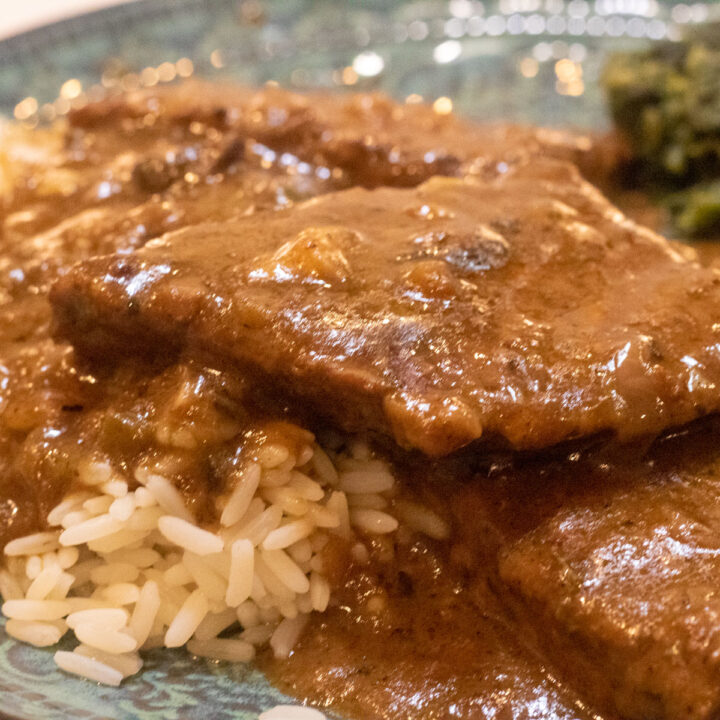
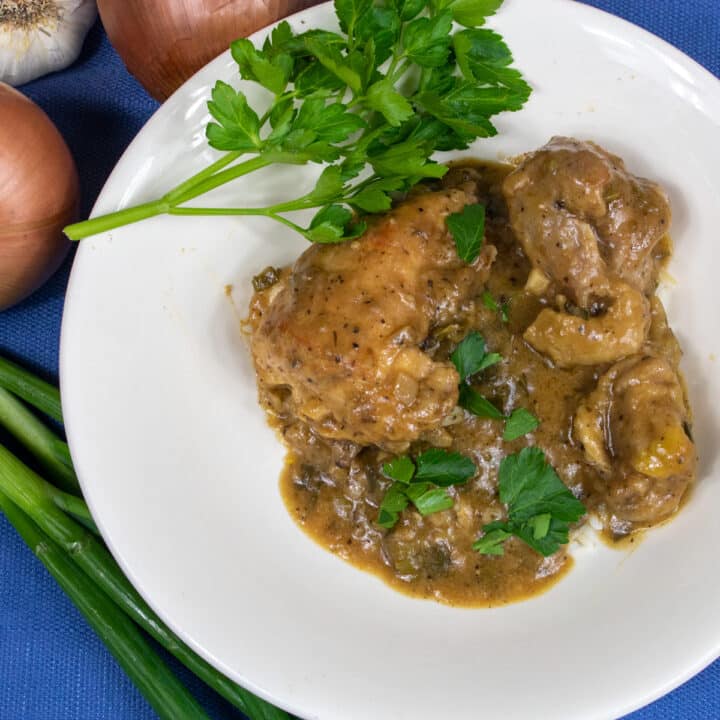
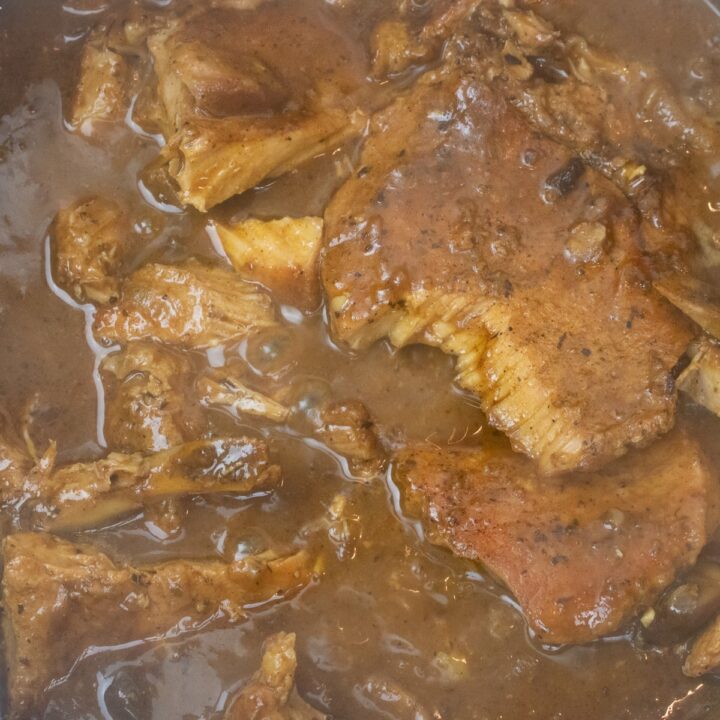
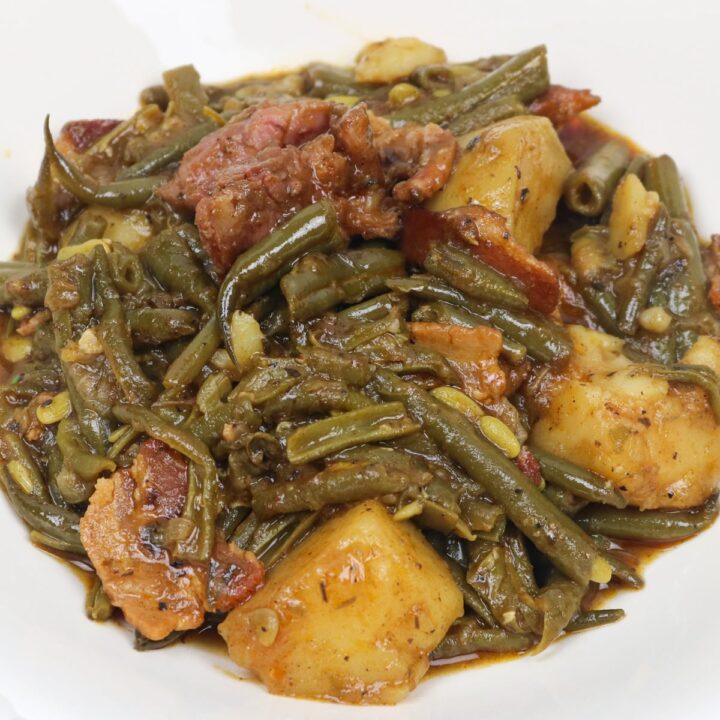
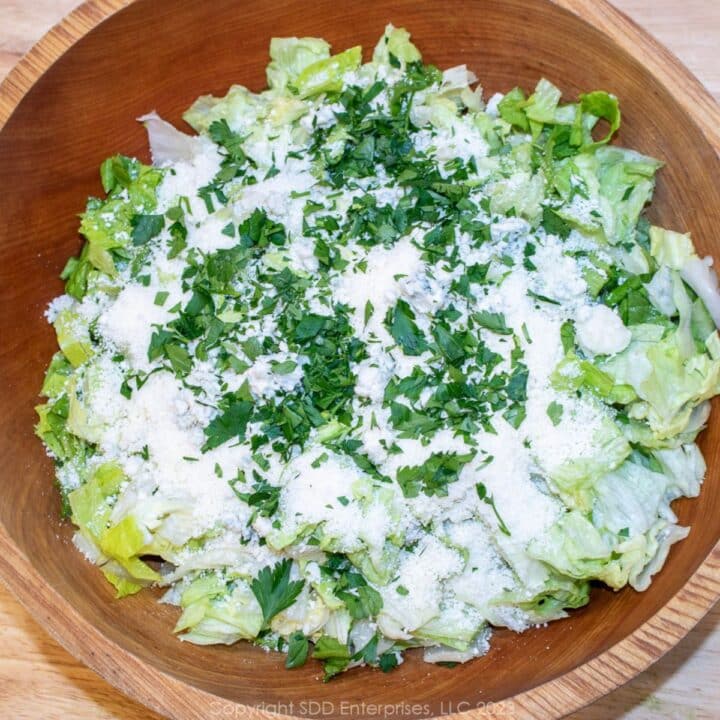
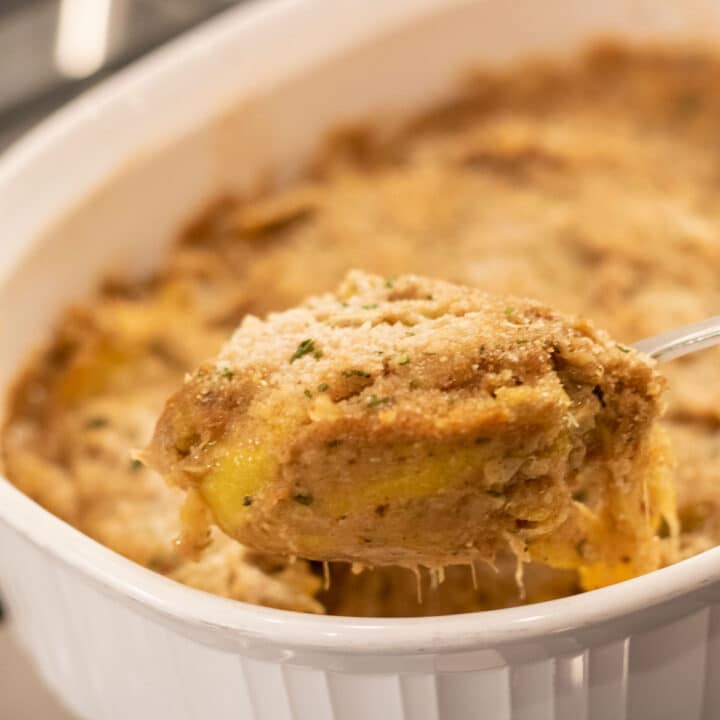
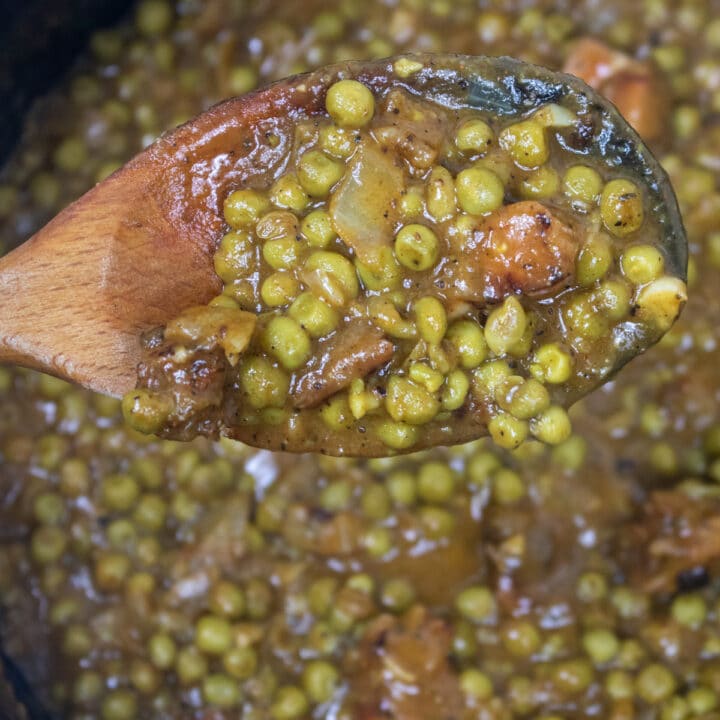
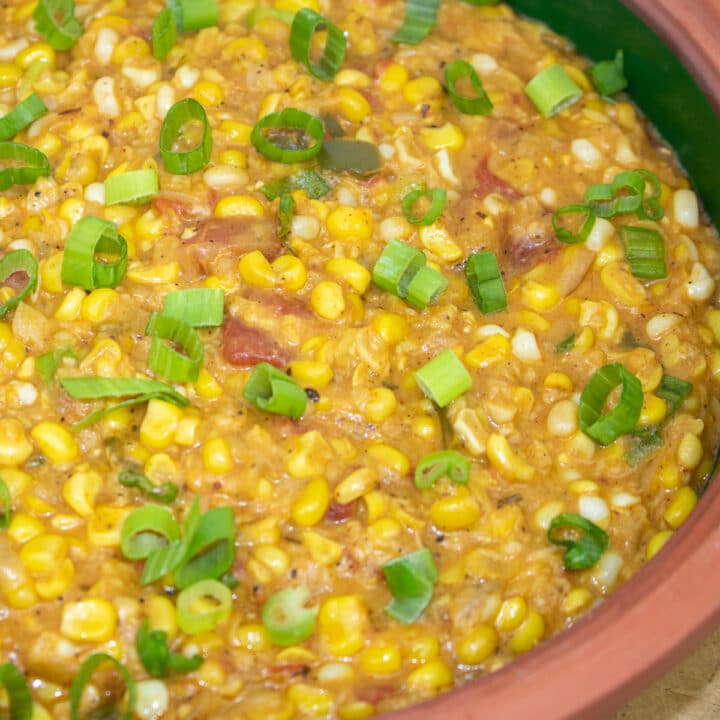
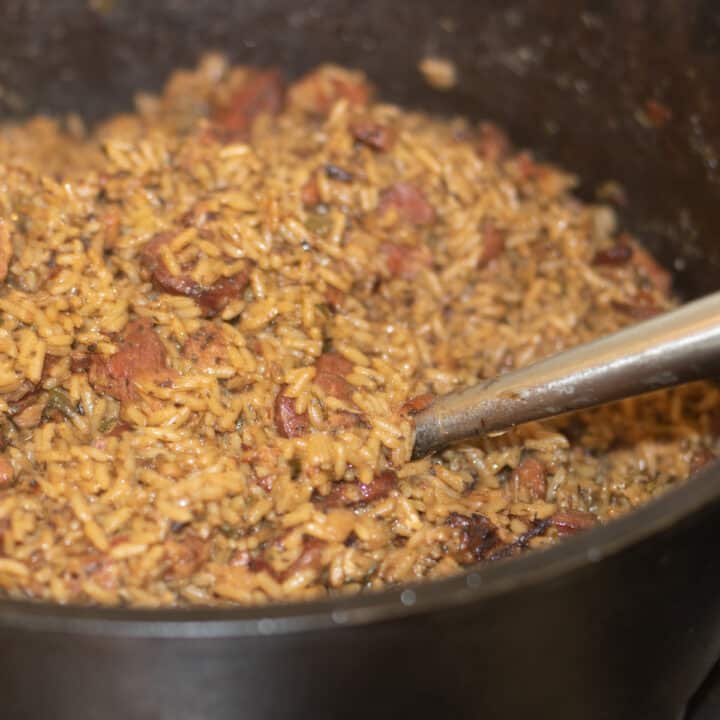
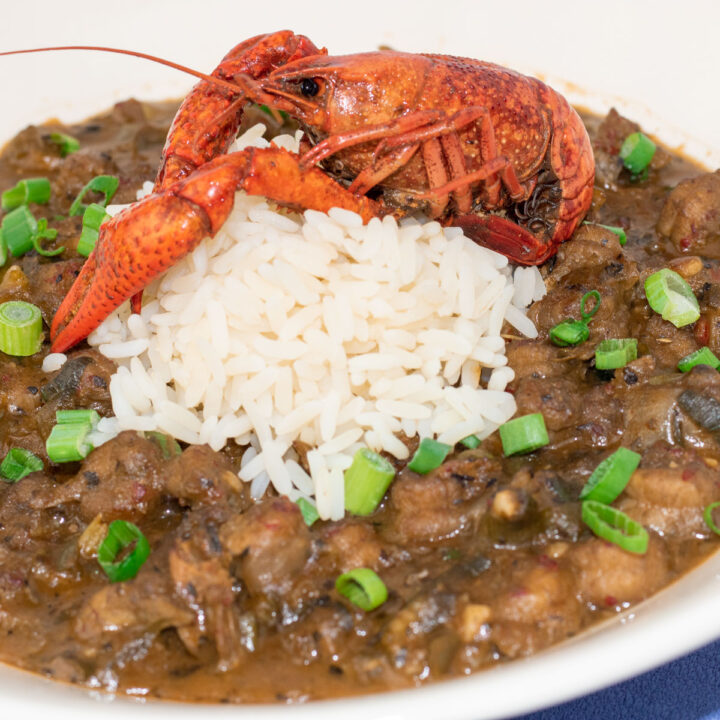
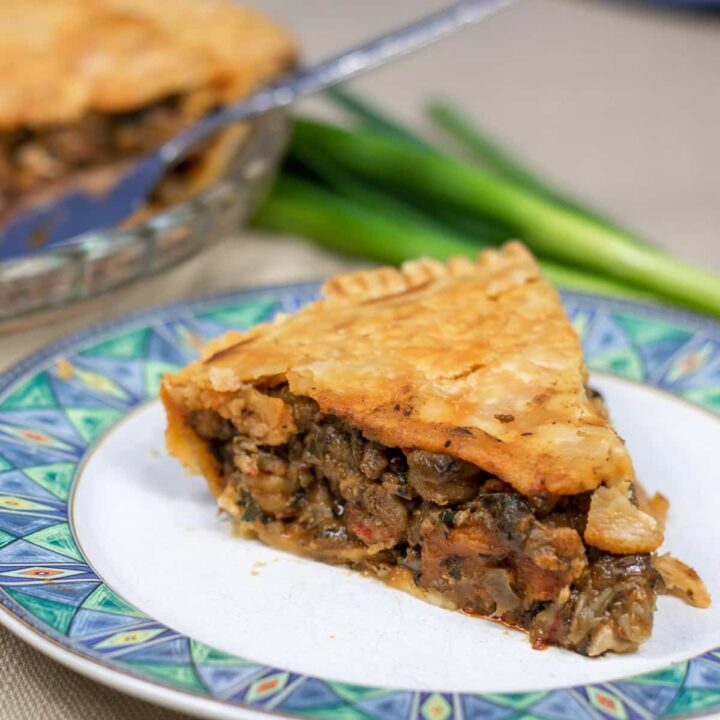
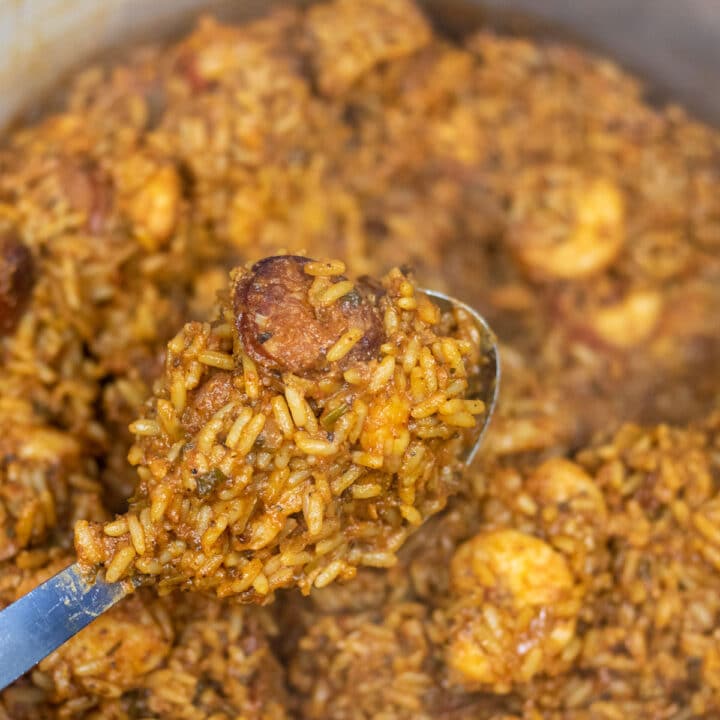
Patrick Michael Miller
Can I substitute half a pound of saviors dressing mix instead of the chicken livers? Just to make it easier. How much Saviors dressing mix half or a whole pound?
Your recipes remind me of home! I love the aromas in the house!
Sweet Daddy D
Hey Patrick, I have never done that but you could sure give it a try. Savoie's has a ton of other ingredients so I'm sure it would impact the flavor profile a good bit. If all you're replacing is the liver, start with 1/2 pound, you could always add more. Remember, although the liver is not a dominant flavor in the recipe, it adds a subtle undertone that makes good "dirty" rice. So, although you "can" do it, it's not something I would do. To save time, I'd try sauteing the chopped livers with the ground meats, instead of preparing them as I have in the instructions. That being said, I always encourage trying things, so if you think it's a good idea, go for it, it may be great.
Thanks for the kind words, make sure to let me know what you end up doing and how it turns out.
Alison DeRudder
20 minutes seems like such a long time to simmer the livers...is there a reason for that? Or is that just how it's done?
Sweet Daddy D
Hi Allison, thanks for reaching out. I simmer the livers that long to get them very tender so that when I chop them and blend them into the other ingredients they breakdown easily and don't end up in big chunks. I've found that some folks don't like liver but if it's completely incorporated they don't usually notice. The flavor is wonderful. I also use the simmering water later in the recipe which picks up more flavor with a long simmer. You certainly don't need to do it that way, just make sure they are cooked through, then give them a fine chop. Thanks again and ENJOY!